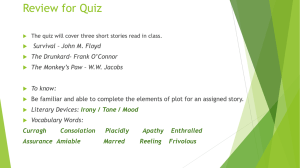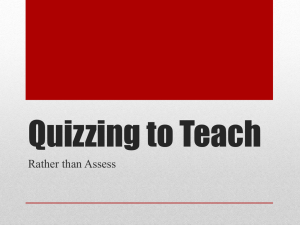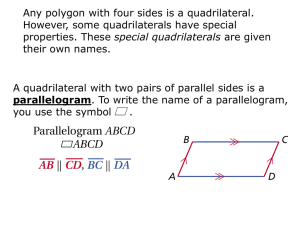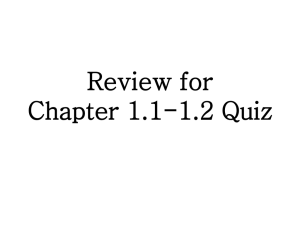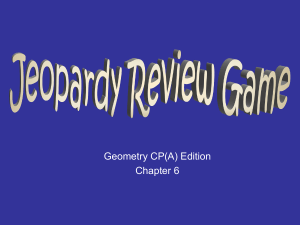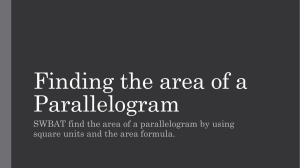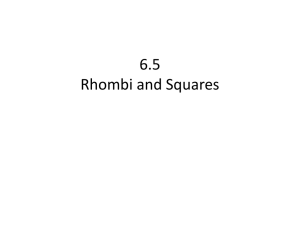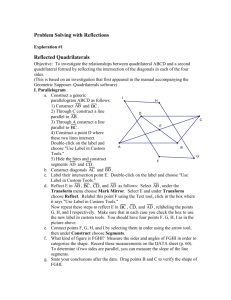Chapter 6 Quizzes
advertisement
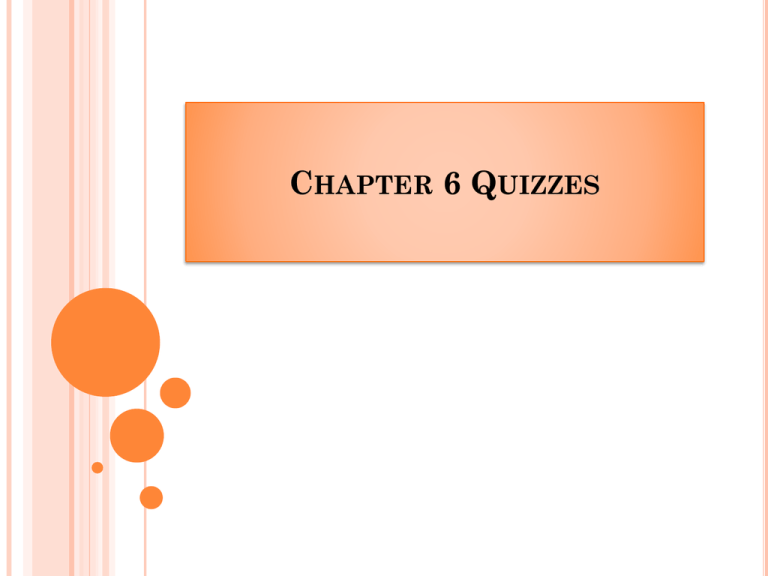
CHAPTER 6 QUIZZES 6.1 Lesson Quiz 1. Name the polygon by the number of its sides. Then tell whether the polygon is regular or irregular, concave or convex. nonagon; irregular; concave 2. Find the sum of the interior angle 1620° measures of a convex 11-gon. 3. Find the measure of each interior angle of a regular 18-gon. 160° 4. Find the measure of each exterior angle of a regular 15-gon. 24° 6.2 Lesson Quiz: Part I In PNWL, NW = 12, PM = 9, and mWLP = 144°. Find each measure. 1. PW 18 2. mPNW 144° 6.2 Lesson Quiz: Part II QRST is a parallelogram. Find each measure. 3. TQ 28 4. mT 71° 6.2 Lesson Quiz: Part III 5. Three vertices of ABCD are A (2, –6), B (–1, 2), and C(5, 3). Find the coordinates of vertex D. (8, –5) 6.3 Lesson Quiz: Part I 1. Show that JKLM is a parallelogram for a = 4 and b = 5. JN = LN = 22; KN = MN = 10; so JKLM is a parallelogram by Theorem 6-3-5. 2. Determine if QWRT must be a parallelogram. Justify your answer. No; One pair of consecutive s are , and one pair of opposite sides are ||. The conditions for a parallelogram are not met. 6.3 Lesson Quiz: Part II 3. Prove the quadrilateral is a parallelogram. E(–1, 5), F(2, 4), G(0, –3), and H(–3, –2) Since one pair of opposite sides are || and , EFGH is a parallelogram by Theorem 6-3-1. 6.4 Lesson Quiz: Part I A slab of concrete is poured with diagonal spacers. In rectangle CNRT, CN = 35 ft, and NT = 58 ft. Find each length. 1. TR 2. CE 35 ft 29 ft 6.4 Lesson Quiz: Part II PQRS is a rhombus. Find each measure. 3. QP 42 4. mQRP 51° 6.4 Lesson Quiz: Part III 5. The vertices of square ABCD are A(1, 3), B(3, 2), C(4, 4), and D(2, 5). Show that its diagonals are congruent perpendicular bisectors of each other. 6.5 Lesson Quiz: 1. Given that AB = BC = CD = DA, what additional information is needed to conclude that ABCD is a square? 6.5 Lesson Quiz 3. Use the diagonals to determine whether a parallelogram with vertices A(2, 7), B(7, 9), C(5, 4), and D(0, 2) is a rectangle, rhombus, or square. Give all the names that apply. AC ≠ BD, so ABCD is not a rect. or a square. The slope of AC = –1, and the slope of BD = 1, so AC BD. ABCD is a rhombus. 6.6 Lesson Quiz: Part I 1. Erin is making a kite based on the pattern below. About how much binding does Erin need to cover the edges of the kite? about 191.2 in. In kite HJKL, mKLP = 72°, and mHJP = 49.5°. Find each measure. 2. mLHJ 81° 3. mPKL 18° 6.6 Lesson Quiz: Part II Use the diagram for Items 4 and 5. 4. mWZY = 61°. Find mWXY. 119° 5. XV = 4.6, and WY = 14.2. Find VZ. 9.6 6. Find LP. 18


